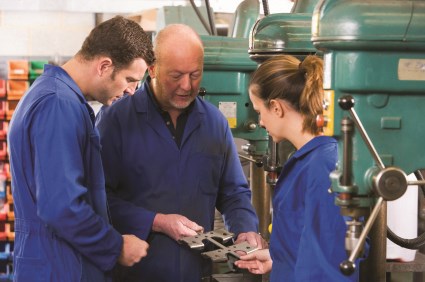Understanding The Four Major Behavioral Styles
Companies today are expanding the role of teams in the workplace in an effort to empower employees and improve organizational effectiveness. The more we try to work as a team, the more important it becomes to recognize that people exhibit different behavioral styles.
Share






Companies today are expanding the role of teams in the workplace in an effort to empower employees and improve organizational effectiveness. The more we try to work as a team, the more important it becomes to recognize that people exhibit different behavioral styles. I use the term “behavioral style”, purposely avoiding the terms “personality” or “attitude” because unless we are psychiatrists or psychologists, we are not qualified to evaluate such things. All that we can see and deal with is a person’s behavior.
There are four major behavioral styles: analytical, amiable, driver and expressive. Please note that I am using an extreme simplification of each particular style. It is doubtful that all people of a particular behavioral style exhibit all of the characteristics portrayed.
Analytical
This behavioral style is noted for the ability to gather and review data. This style is typical of people in technical positions such as engineering, accounting and information technology. Details and accuracy are important to these people, and they take great pride in providing information that is correct.
Skills: Analyticals are persistent and don’t mind spending extra time to make sure things are right. For the most part, they are orderly and present ideas or solutions in an orderly manner.
Caution: Due to their desire for accuracy and attention to detail, analyticals can come across as indecisive. They can also be critical of solutions that veer from what the “facts” say. They have little use for gut feelings and may go to great lengths to avoid dealing with those who do.
Favorite word: Why?
Best Performance: Allow them sufficient time to gather and interpret information.
Amiable
Amiables are highly supportive individuals interested in establishing and maintaining relationships in an organization. This behavioral style is typical of employees in human resources and social or medical services.
Skills: Amiables are great at achieving consensus within an organization. They can effectively facilitate groups and bring sides together to develop a win/win solution.
Caution: Sometimes an amiable person’s desire to reach agreement may cause the person to conform too easily, intent in maintaining relationships rather than reaching the best solution.
Favorite word: We.
Best Performance: Encourage amiables to initiate and stand behind their ideas. Allow them to maintain relationships in the organization.
Driver
Drivers, as the name implies, are often the driving force behind getting things done in an organization. They are results-oriented individuals who are motivated by goals. Drivers typically gravitate to positions in management and sales.
Skills: Drivers are effective at time management, seeming to possess an innate ability to devote just the right amount of time and effort to things that need to be done. Drivers rarely struggle with making decisions.
Caution: Because they are so driven for success in a timely manner, drivers may neglect the impact that their actions have on others. They may be viewed as willing to do almost anything to get the job done.
Favorite word: When?
Best Performance: Give them options and probabilities, allowing them to formulate their own decisions whenever possible.
Expressive
Expressives are company visionaries, good at grasping the big picture. Expressives typically gravitate to positions in marketing and strive to get ahead in an organization. They are truly the “politicians” in an organization, establishing and using contacts extensively.
Skills: If you need to develop new concepts, then enlist the help of an expressive. Their ability to size up a situation based on personal experience can assist them in finding creative solutions, perhaps never considered by others.
Caution: Being so confident of their “gut feelings,” they may often ignore or neglect facts that are presented to them. Their lack of attention to detail can be an obstacle.
Favorite word: I.
Best Performance: Show interest in their ideas and compliment them, even if you are not sure they are totally deserving of such praise.
There is no one best behavioral style, and it is not your personal style that is important. What is important is recognizing the behavioral style of others so that you can deal with them effectively.
Related Content
4 Commonly Misapplied CNC Features
Misapplication of these important CNC features will result in wasted time, wasted or duplicated effort and/or wasted material.
Read More6 Machine Shop Essentials to Stay Competitive
If you want to streamline production and be competitive in the industry, you will need far more than a standard three-axis CNC mill or two-axis CNC lathe and a few measuring tools.
Read MoreTips for Designing CNC Programs That Help Operators
The way a G-code program is formatted directly affects the productivity of the CNC people who use them. Design CNC programs that make CNC setup people and operators’ jobs easier.
Read MoreHow to Mitigate Risk in Your Manufacturing Process or Design
Use a Failure Mode and Effect Analysis (FMEA) form as a proactive way to evaluate a manufacturing process or design.
Read MoreRead Next
Setting Up the Building Blocks for a Digital Factory
Woodward Inc. spent over a year developing an API to connect machines to its digital factory. Caron Engineering’s MiConnect has cut most of this process while also granting the shop greater access to machine information.
Read MoreBuilding Out a Foundation for Student Machinists
Autodesk and Haas have teamed up to produce an introductory course for students that covers the basics of CAD, CAM and CNC while providing them with a portfolio part.
Read More5 Rules of Thumb for Buying CNC Machine Tools
Use these tips to carefully plan your machine tool purchases and to avoid regretting your decision later.
Read More



















.png;maxWidth=300;quality=90)














.png;maxWidth=970;quality=90)